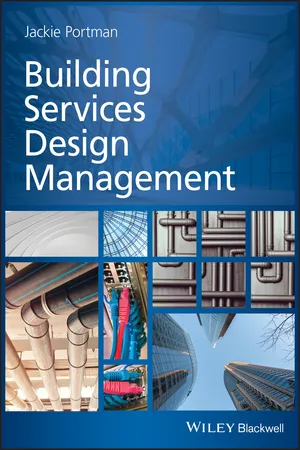
- English
- ePUB (mobile friendly)
- Available on iOS & Android
Building Services Design Management
About This Book
Building services refers to the equipment and systems that contribute to controlling the internal environment to make it safe and comfortable to occupy. They also support the requirements of processes and business functions within buildings, for example manufacturing and assembly operations, medical procedures, warehousing and storage of materials, chemical processing, housing livestock, plant cultivation, etc.
For both people and processes the ability of the building services engineering systems to continually perform properly, reliably, effectively and efficiently is of vital importance to the operational requirements of a building. Typically the building services installation is worth 30-60% of the total value of a contract, however existing publications on design management bundles building services engineering up with other disciplines and does not recognise its unique features and idiosyncrasies.
Building Services Design Management provides authoritative guidance for building services engineers responsible for the design of services, overseeing the installation, and witnessing the testing and commissioning of these systems. The design stage requires technical skills to ensure that the systems are safe, compliant with legislative requirements and good practices, are cost-effective and are coordinated with the needs of the other design and construction team professionals. Covering everything from occupant subjectivity and end-user behaviour to design life maintainability, sequencing and design responsibility the book will meet the needs of building services engineering undergraduates and postgraduates as well as being an ideal handbook for building services engineers moving into design management.
Frequently asked questions
Information
Part One
The operating context
1
The operating environment
Chapter outline
Examples of vision statements
Examples of mission statements
- provide superior client service and delight our clients
- act equitably and honourably with our suppliers
- protect and enhance the quality of the built and natural environment
- encourage innovation and creativity in design
- practice sustainable development.
1.1 Organisational arrangement
- ownership arrangement
- scope of building services engineering offered
- integration with other entities
- types of projects undertaken by building sector
- geographical operating span.
Ownership arrangement
Scope of services

Integration with other entities
Table of contents
- Cover
- Title page
- Copyright page
- Preface
- About the author
- Introduction
- Part One: The operating context
- Part Two: Technical issues associated with building services design
- Part Three: The design management process
- Part Four: Special buildings
- Index
- End User License Agreement